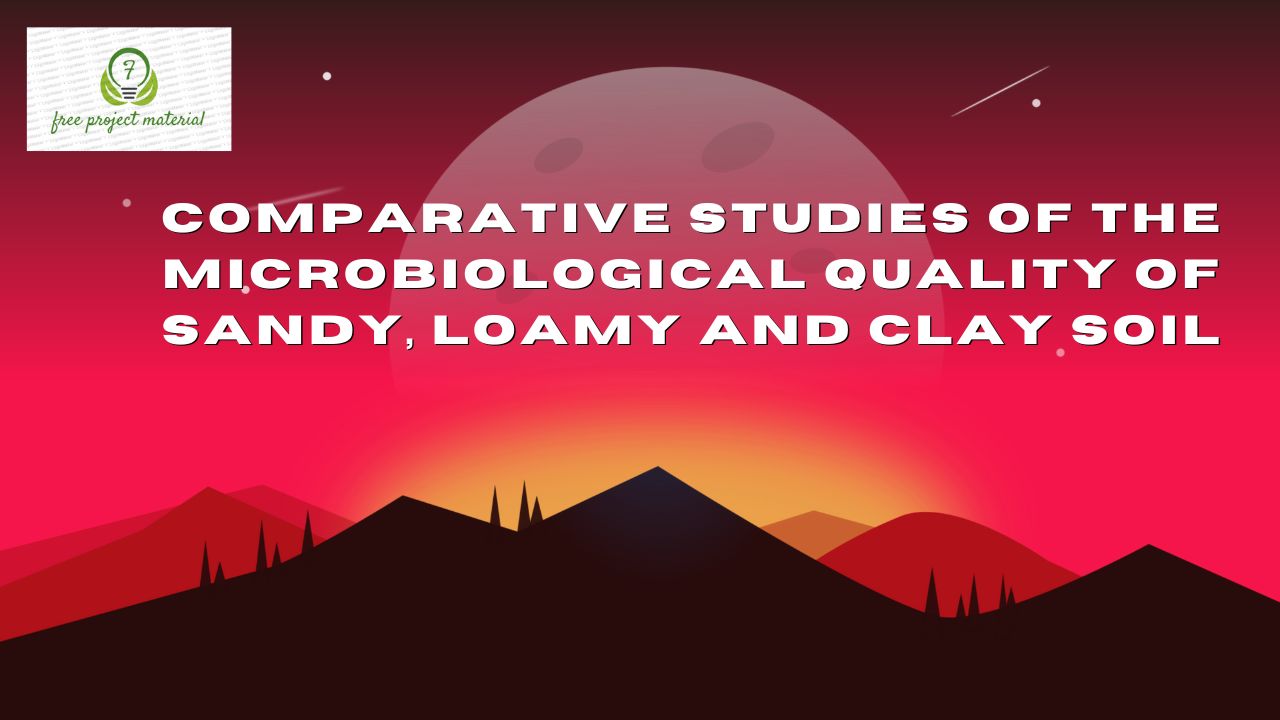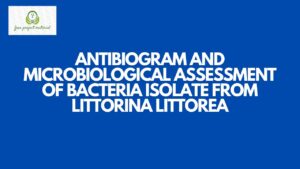ABSTRACT
The aim of this study was to investigate the comparative microbiological composition of sandy, loam and clay soil. Different soil samples were collected for the study (sandy, loamy and clay). Standard aseptical laboratory methods were employed in carrying out the study. The result of the revealed that loamy soil had the highest heterotrophic bacterial count of 5.0×107 cfu/g while clay soil had the least (1.8×107 cfu/g). The highest heterotrophic fungal was observed in loamy soil with 1.2×106 cfu/g, while clay soil had the least with 0.4×106 cfu/g The bacterial isolates obtained were Escherichia sp, Bacillus sp, Staphylococcus sp and Streptococcus sp. with percentage of occurrence 24.7%, 29.0%, 26.9% and 19.4% respectively. The fungal isolates obtained were Candida sp (14.3%), Aspergillus sp (52.4%) and Fusarium sp. the result revealed that loamy soil has higher microbial community followed by sandy soil and lastly clay soil. This could be a contributing factor to the ability of loamy soil to support plant growth as well as its suitability for cultivation of crops. It was therefore recommended that the microbial community of the soil should be maintained through the application of manure, instead of fertilizer.
TABLE OF CONTENT
Title Page – – – – – – – – – i
Certification – – – – – – – – ii
Dedication – – – – – – – – – iii
Acknowledgements – – – – – – – iv
Abstract – – – – – – – – – v
Table of Contents – – – – – – – – vi
CHAPTER ONE
INTRODUCTION
1.1 Background of the Study – – – – – – 1-4
1.2 Aim and Objective of the Study – – – – – 4-5
1.3 Scope and Limitation of the Study – – – – 5
CHAPTER TWO: LITERATURE REVIEW
2.1 Microbiota of the Soil – – – – – – – 6
2.1.1 Bacteria – – – – – – – – 6-10
2.1.2 Fungi – – – – – – – – – 10-13
2.1.3 Cyanobacteria and Algae – – – – – – 13-14
2.1.4 Protozoa – – – – – – – – 14-15
2.2 Variation in soil Bacteria Community Composition – – 15-18
2.3 Variation in Soil Fungal Community Composition – – 18-22
2.4 Types of Soil – – – – – – – – 23-24
2.5 Soil Texture – – – – – – – – 25-26
2.6 Soil Structure – – – – – – – – 26-30
2.7 Factors in influences the Growth of Soil Microbes – – 31-34
CHAPTER THREE: MATERIAL AND METHOD
3.1 Materials – – – – – – – – 35
3.2 Methods – – – – – – – – – 35
3.2.1 Sample Collections – – – – – – 35-36
3.2.2 Serial Dilution – – – – – – – 36
3.2.3 Sterilization of Glasswares and Agents – – – – 37
3.2.4 Cultivation of Micro-organisms – – – – – 37
3.2.5 Enumeration of Micro-organisms – – – – 38
3.2.6 Characterization of Bacterial Isolates – – – – 38
3.2.7 Characterization of Fungal Isolates – – – – 39
CHAPTER FIVE: RESULT AND DISCUSSION
4.1 Result – – – – – – – – – 40-48
4.2 Discussion – – – – – – – – – 49-52
CHAPTER FIVE: CONCLUSION AND RECOMMENDATIONS
5.1 Conclusion – – – – – – – – 53
5.2 Recommendations – – – – – – – – 53-54
References
CHAPTER ONE
1.0 INTRODUCTION
1.1 Background of the Study
Soil is the region on the earth’s crust where geology and biology meet, the land surface that provides a home to plant animal and microbial life (Pelczar et al., 2005). Soil teems with microscopic life (bacteria, fungi, algae, protozoa and viruses) as well as macroscopic life such as earthworms, nematodes, mites and insects, and also the root system of plants. The numbers and kinds of micro-organisms present in soil depend on many environmental factors amount and type of nutrients available, available moisture, degree of aeration pH, temperature etc (Prescott et al., 1999). Soil bacteria and fungi play pivotal roles in various biochemical cycles and are responsible for the recycling of organic compound (Wall and Virginia, 1999). Soil micro-organisms also influences above ground ecosystems by contributing to plant nutrition, plant health, soil structure and soil fertility (O’ Donnell et al., 2001). Soil is generally a favourable habitat for the proliferation of microorganisms. With micro colonies, developing around soil particles. Numbers of micro organism in soil habits normally are much higher than those in fresh water or marine habitats (Atals and Bartha, 1998).
Bacteria make up the most abundant group of microorganisms in the soil (3.0×106-5.0×108) per gram of soil followed by the actinomyceter (1.0×106-2.0×107),fungi (5.0×103-9.0×106), yeast (1.0×103-1.0×106), algae and protozoa (1.0×103-5.0×105) and nematodes (5-200) counts per gram of soil are wide differences in the relative proportions of individual bacteria genera found in particular soils (Atals and Bartha, 1998). Soil fungi may occur as free- living organisms or in mycorrhizal association with plant roots. Fungi are found primarily in the top 10cm of the soil and are rarely found below 30cm. they are most abundant in well aerates and acidic soils (Domsch et al., 2010). Most fungi in soil are opportunistic (zymogenous). They grow and carry out active metabolisms when conditions are favourable which implies adequate moisture, adequate aeration and relatively high concentrations of utilizable substrates (Miyanoto et al., 2002).
Although soil organisms only constitute a tiny fraction of the total soil, their presence and activity are essential in forming and modifying the soils physical and chemical characteristics. The numbers and diversity of soil organisms is enormous compared to other habitats on earth, and the characterization of the populations and their dynamics is still in its infancy.
Soil biota can be grouped according to size in microbiota, mesobiota and macrobiota. Microbiota consist of bacteria, actinomycetes, fungi, algae and protozoa. They are the dominating group, both according to numbers and total biomass. Mesobiota consist of nematodes, enchytracids, collembolan or springtails, mites, rotifers and small insects. Macrobiota consist of earthworms, mollusks and larger arthropods. These larger groups are particularly important in modifying soil structure and regulating other soil populations by predation (Miyanoto et al., 2002) many soil processes, particularly those related to nutrient turnover and mineralization of organic matter are controlled by the soil biota. These processes are essential for the soils capacity to function and carry out vital ecosystem services as buffering and filtering of nutrients and water, and providing a basis for plant production.
Soil quality and the biota within it are closely interlinked. Soil physical properties as structure, infiltration rate and water holding capacity are influenced by the activity of mainly macrobiata. Conversely, the activity of soil organisms is influenced by the living conditions in the soil. Several attempts to use soil biota as indicators for quality have been tired, but so far no standard indicators have been identified (Miyanoto et al., 2002)
Although many biological processes in soil are resistant and resilient enough to withstand significant stress, key processes can be reduced or even cease if exposed to adverse conditions. Experience shows that soil functions may be lost, without being noticed, even while the soil appears to be functioning.
1.2 Aim and Objectives of the Study
The aim of this research project is to analyzed the microbial load of sandy, loamy and clay soil.
And the objectives of this research project is to;
(i) To determine the total microbial count of sandy, loamy, clay soils
(ii) To isolate and identify bacterial present in sandy, loamy and clay soils
(iii) To isolate as identify using sandy, loamy and clay soil
(iv) To make recommendations base on the result the this work
1.3 Scope and Limitation of the Study
The design of this research project is to investigate and analyzed the microbial load of sandy, loamy, and clay soil. Due to time, and financial constraints of sandy, loamy, and clay soil.

